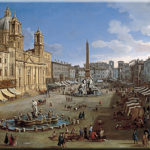This phrase signifies the period when the Roman state and those overseas provinces it had formed were under the rule of an emperor. The first ‘Emperor’ was Augustus (27 BC), and the empire as such existed but not always flourished for nearly five centuries, until 476 AD.
The empire was divided in 373 (by Theodosius) into the Western and Eastern empires. The term is often used to refer to all Roman territories during both the republic and the empire. This thinking is probably incorrect – or at least, injudicious.
Rome as a city gained power from the time of the Tarquins in the 6th century BC, some three centuries before Alexander the Great (qv). The city state subdued the Etruscans, Sabines, Samnites and Greek settlers. By the third century BC Rome controlled all Italy. Conflicts with Carthage occurred in the western Mediterranean, and there were problems with the Hellenistic powers in the east, but success in the Punic Wars (qv) gave Rome its first overseas possessions – in Sicily, then Spain and North Africa. The Macedonian Wars finally left Rome dominant in Macedonia, Greece and parts of Asia Minor.
Campaigns supervised by Pompey and Julius Caesar added Gaul (from the river Rhine to the Atlantic) and Syria. After the battle of Antium (31 BC) Egypt was ‘annexed’. The great Augustus had plans to consolidate the empire within natural boundaries such as river or mountain. In 43 AD emperor Claudius (Clo-Clo-Claudius) invaded Britain. The Romans only occupied parts of what is now England, all attempts to defeat what is now Scotland were in vain, and saved the administrators a lot of unnecessary trouble.
The emperor Trajan made Dacia a province in 106, in responde to raids across the Danube, but it was abandoned as worthless in 270. Trajan also briefly held Mesopotamia (114 – 117). This great empire appeared to be glued together, difficult as it sounds in an epoch when the fastest transport was provided by camel, horse or mule. Communications were however sound, and internal peace was maintained by the presence of the Roman legions. Roman fleets (triremes) kept the oceans safe for shipping, and an extraordinary system of Roman roads (no-one had seen a road before) was built by engineers to move soldiers rapidly, make trade and travel more comfortable, and facilitate an imperial postal system.
A single legal system was incorporated, and there were two official languages, Latin in the west and Greek in the east. Roman cities were established which flourished perhaps because urban corruption was halted by instant sentence of death if discovered. Few of today’s politicians would have grown old if they had had power in the time of the Roman Empire.
Roman influence and culture reached India, Russia, South-east Asia, even China via the silk route. Finally, it was the success of the empire which contributed towards its collapse, provoked by internal power struggles, and unchecked invasions by hungry tribes. Rome was at last sacked by Visigoths in 410, Roman Carthage was demolished by the Vandals in 455, and in 476, Romulus Augustulus, the last emperor, was deposed. The Eastern Empire however survived until 1453, under the name of ‘The Byzantine Empire’.










Leave A Comment